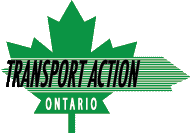By
Transport Action Ontario
|
Latest News ,
Press Releases and Open Letters
Welcome to the New Year of 2017. May it be happy and prosperous for you!
Our path forward Transport Action Ontario has a full agenda for 2017. In the fall of 2016, TAO decided to focus its advocacy on intercity rail and connectivity, the integration of public transport into a network of services that includes intercity rail, regional bus and rail services, and local transit. We will oppose the bad and the ugly, support the good, and call for and champion initiatives that take Ontario closer to a sustainable public transportation system. We highly value local public transit, but will rely on and work with other groups already doing transit advocacy. Metrolinx will remain as a focus as a provider of regional intercity transit.
Ontario is facing a large public transportation deficit. Most of the province is without intercity or even local public transportation. While the Province has invested in transit in the Greater Toronto and Hamilton Area, and in Ottawa, the rest of the province is stuck with auto-dependency. There is a heavy price to auto-dependency which disadvantages students and seniors and people with low incomes generally. Auto-dependency is a drag on local economic development hampering labour mobility and spurring depopulation. While the Province recognizes that it must work to help reverse climate change, it has not recognized that a key way to do that is to provide public transport alternatives to the whole of Ontario.
Southwestern Ontario Cuts to VIA Rail service in 2012 hit Southwestern Ontario particularly hard. TAO, along with several other local groups, looked at how an integrated network of rail and bus services could be brought to this part of Ontario. The Network Southwest plan, written by Greg Gormick and released in 2015, proposes a provincially supported bus network integrated with an upgraded and expanded rail network. Frequent train service using bi-level passenger cars following the model of state-supported Amtrak services in California and elsewhere in the U.S. is highlighted. Another report in 2016, also written by Gormick, explores the concept of High Performance Rail in detail.
The objectives of these two reports still apply. Southwestern Ontario desperately needs integrated public transportation. In 2017 TAO will give special attention to the North Main Line, the rail line between Toronto, Guelph, Kitchener, Stratford, St. Marys and London. VIA Rail is providing very poor and extremely unreliable train service on this route. The Province has mandated Metrolinx to offer commuter rail service from Kitchener into Toronto, but Metrolinx’s commuter trains make many stops and are slow. Moreover, the transportation demand along the North Main Line doesn’t end at Kitchener. It extends west to Stratford and London. It is time for frequent all-day two-way express rail service the full length of the Innovation (Knowledge) Corridor Toronto-Kitchener-London. TAO will be advocating high performance rail for this corridor with a delivery agency to be worked out through agreements between the feds, the province, and the municipalities being served.
Northern Ontario The cancellation of the Northlander between Toronto, North Bay and Cochran in 2012, the infrequency and unreliability of VIA’s Canadian across northwestern Ontario, declining intercity bus service, and the recent suspension of the Sault-Hearst train underscore the substantial decline in public transportation options for northern Ontario. In 2017, TAO will continue to work closely with the Northeastern Ontario Rail Network based in North Bay, and the Coalition for Algoma Passenger Trains based in the Sault to bring back and enhance rail/bus and transit services for Ontario’s north.
Eastern Ontario VIA Rail has proposed building a new exclusive passenger railway from Toronto to Smith Falls through Peterborough and Havelock as part of its High Frequency Rail plan. VIA is proposing frequent rail service between Toronto, Ottawa and Montreal on this route using non-stop trains. TAO is opposed to this plan as costly and unnecessary. VIA has already paid close to half a billion dollars for added track on CN’s Lakeshore route Toronto-Kingston-Brockville-Montreal to help reduce conflicts between passenger and freight trains on this route. Perhaps in anticipation of blow back from cities such as Belleville and Kingston, VIA recently proposed adding almost hourly train service to the Lakeshore route in addition to the new dedicated track proposal. TAO’s position is to support frequent high performance passenger rail along the Lakeshore route by investing scarce capital funds on continuing to upgrade the Lakeshore line with the aim of having both frequent express trains Toronto-Ottawa-Montreal connecting with stopping trains serving cities in eastern Ontario.
Ongoing projects As part of the Move the GTHA collaborative, TAO will continue to push for new dedicated revenue sources for transporation investment. If implemented properly, these can provide funding needed for public transport improvements all across Ontario. There continues to be a need for federal legislation definiing the rights and obligations of passenger rail in Canada, especially if operating on track owned by the freight railways. We have been inputting into a Private Members Bill on this topic to be introduced in 2017.
Longer term TAO supports rail investments to upgrade international connections to the U.S. from Ontario. Both New York and Michigan are investing to implement high performance rail, in New York between Niagara Falls and New York City, and in Michigan between Detroit and Chicago. TAO supports passenger rail connections between Ontario and the U.S. at Niagara Falls and at Windsor.
Highlighted above are several big issues for TAO in 2017. Others will surely arise. We look forward to your support through membership and donations that will help us carry forward these and other activities to achieve sustainable integrated public transportation for Ontario.
Tony Turrittin, President, January 3, 2017

